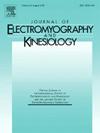Shoulder load during wheelchair-related activities of daily life
IF 2
4区 医学
Q3 NEUROSCIENCES
引用次数: 0
Abstract
Manual wheelchair users experience significant upper extremity strain, leading to a high prevalence of shoulder pain. Identifying modifiable risk factors for shoulder complaints is crucial for developing effective interventions. Consequently, it’s important to quantify shoulder load (magnitude, frequency and duration) experienced by manual wheelchair users throughout the day.
This study aims to quantify the magnitude of shoulder load during various daily activities, including wheelchair propulsion at different speeds and inclines, ascending and descending ramps, weight relief lift, material handling and desk work. Ten able-bodied participants performed these activities while their upper extremity kinematics and exerted forces were measured. The analysis focused on glenohumeral contact force and rotator cuff muscle forces using the Delft Shoulder and Elbow Model.
Highest mean glenohumeral contact forces were found during weight relief lift (1363 ± 1204 N), followed by descending a ramp (997 ± 1043 N) and fast propulsion (802 ± 742 N). The supraspinatus muscle generated the greatest force during weight relief lift (327 ± 490 N) and fast propulsion (184 ± 205 N). These findings provide a first reference for estimating joint load in daily activities. By combining these data with the individual activity frequency and duration, personalized shoulder load exposure can be assessed, informing the development of targeted interventions to reduce shoulder pain in manual wheelchair users.
日常生活中与轮椅有关的活动中的肩部负荷
手动轮椅使用者会经历明显的上肢劳损,导致肩部疼痛的高发。确定可改变的肩部疾病风险因素对于制定有效的干预措施至关重要。因此,量化手动轮椅使用者全天所经历的肩部负荷(强度、频率和持续时间)是很重要的。本研究旨在量化各种日常活动中肩负荷的大小,包括轮椅在不同速度和倾斜度下的推进,上升和下降的斜坡,减轻重量的升降机,物料搬运和案头工作。10名身体健全的参与者在进行这些活动的同时,测量了他们的上肢运动学和施加的力。使用Delft肩肘模型分析肩关节接触力和肩袖肌肉力。平均肩关节接触力在卸重提升(1363±1204 N)时最高,其次是下降坡道(997±1043 N)和快速推进(802±742 N)。在负重提升(327±490 N)和快速推进(184±205 N)时冈上肌产生的力最大。这些发现为估计日常活动中的关节负荷提供了第一个参考。通过将这些数据与个人活动频率和持续时间相结合,可以评估个性化的肩部负荷暴露,为制定有针对性的干预措施提供信息,以减少手动轮椅使用者的肩部疼痛。
本文章由计算机程序翻译,如有差异,请以英文原文为准。
求助全文
约1分钟内获得全文
求助全文
来源期刊
CiteScore
4.70
自引率
8.00%
发文量
70
审稿时长
74 days
期刊介绍:
Journal of Electromyography & Kinesiology is the primary source for outstanding original articles on the study of human movement from muscle contraction via its motor units and sensory system to integrated motion through mechanical and electrical detection techniques.
As the official publication of the International Society of Electrophysiology and Kinesiology, the journal is dedicated to publishing the best work in all areas of electromyography and kinesiology, including: control of movement, muscle fatigue, muscle and nerve properties, joint biomechanics and electrical stimulation. Applications in rehabilitation, sports & exercise, motion analysis, ergonomics, alternative & complimentary medicine, measures of human performance and technical articles on electromyographic signal processing are welcome.

 求助内容:
求助内容: 应助结果提醒方式:
应助结果提醒方式:


